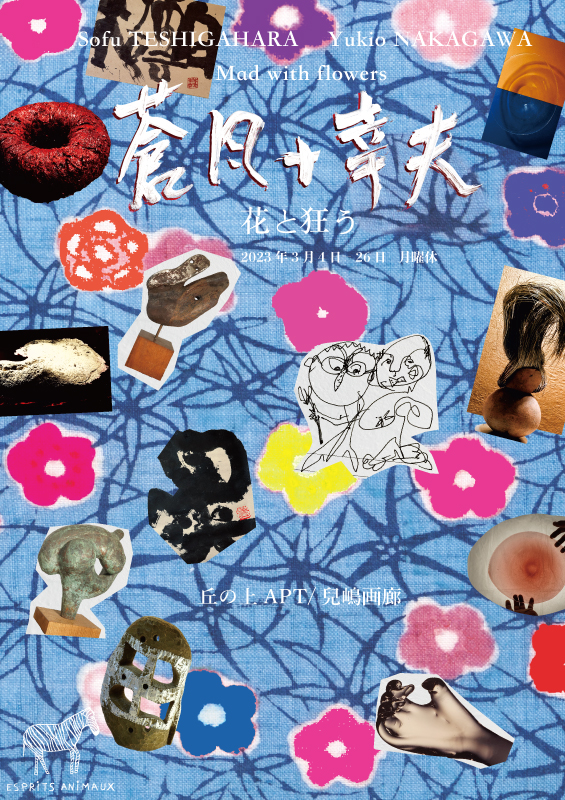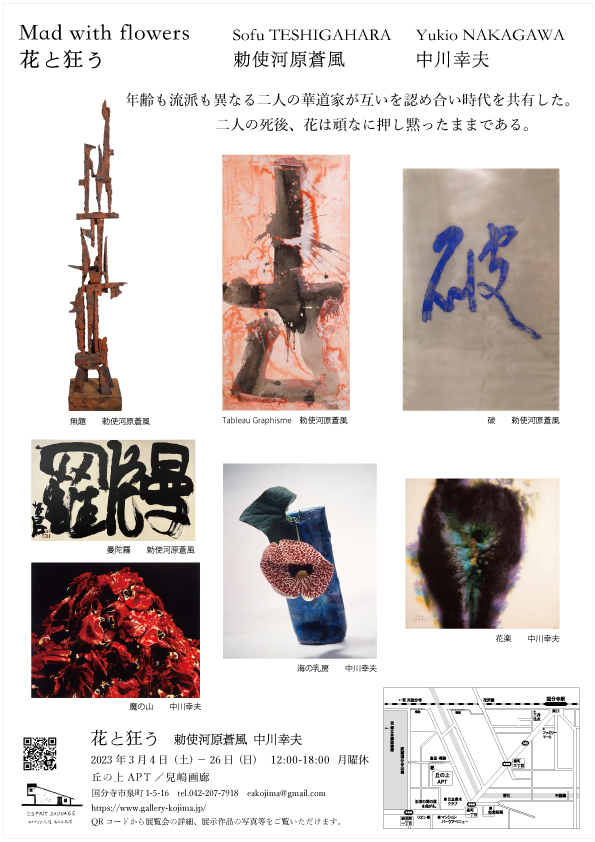年齢も流派も異なる二人の華道家が互いを認め合い時代を共有した。
二人の死後、花は頑なに押し黙ったままである。
Sofu Teshigahara [1900-1979] and Yukio Nakagawa [1918-2012].
Two flower artists of different ages and schools appreciated each other and lived the same era.
After their death, flowers remain stubbornly silent.


「勅使河原蒼風 中川幸夫 花と狂う」
会期: 2023年3月4日(土) − 3月26日(日) 12:00-18:00 (月曜休廊)
場所: 兒嶋画廊 (国分寺市泉町1-5-16)
問合せ: eakojima@gmail.com tel.042-207-7918
Sofu Teshigahara + Yukio Nakagawa “Mad with Flowers”
March 4th – 26th, 2023 12:00-18:00 (Closed on Mondays)
Gallery Kojima
eakojima@gmail.com landline.+81-42-207-7918
※The artists’ bio and exhibition history are at the end of this page.
展示予定作品
>>>Artsyで展示作品をご覧いただけます。| Find the works on ARTSY
【展示作品: 勅使河原蒼風】
↓スクロールダウンと”More”をクリックで作品画像をご覧頂けます↓
【展示作品: 中川幸夫】
↓スクロールダウンと”More”をクリックで作品画像をご覧頂けます↓
20代でいけばなと出会い、33歳で池坊を脱退、流派を離れて38歳で上京。あらゆる組織、流派に属さず、弟子をとらず、ひとりで作家活動を行ない、前衛的・革新的な作品を生み続けた。花の本質を追求し、従来の概念を破る表現、その特異な作品は、国の内外で高い評価を得ている。
Nakagawa encountered Ikebana throughhis aunt (master of Ikebana, Ikenobo School) and in 1942 he became a pupil of his aunt. However, after some consideration towards traditional Ikebana,he left Ikenobo School and became independent in 1951. After the war, he began thehistorically significant Ikebana movement, the so-called “avant-garde Ikebanamovement” together with Houn Ohara and Sofu Teshigahara, which deviated fromconventional practices of Ikebana beyond their differences in schools. Whilebeing trained in Ikebana, Nakagawa was not limited to traditionalflower arrangement arts but made his own unique works, usingflowers, fruits, vegetables, potteries, antiques, Japanese papers and natural stones. Inaddition to flower works, his works included glass objects, painting,calligraphy, and performance arts collaborating with contemporary dancer KazuoONO. He also learned photography from Ken DOMON and took photographs of hisworks by himself.
[Major Exhibition]
1949 first solo exhibition “Hana (Flower)”
1952 stage installation for the dance performance celebrating the twelfth centennial ofthe great Buddha of Todaiji Temple, Nara
1954 invited artist to the Modern Art Fair
1968 firstsolo exhibition in Tokyo, Ito Gallery
1878 won the award of Schonste Bucher aus Aller Welt, Leipzig, Germany
1984 first solo exhibition of karaku works “Karaku; Flower/Water”
1989 group exhibition “Calligraphy and Sumi Paintings of Five Artists”
1999 Won the Oribe Grand Award, the Second Oribe Award, Recognized as Person of Cultural Merits, Marugame City
2004 Won the Achievement Award for the Promotion of Contemporary Japanese Arts, Won the Higashikawa Prize, Domestic Photographer Prize
2005 exhibitions at Niki Gallery SATSU, Tokyo, the Miyagi Museum Of Art, and the Tokyo Metropolitan Teien Art Museum
[Public Collection]
Fondation Cartierpour l’Art Contemporain, France
The Museum ofModern Art, Kamakura, Japan
Marugame InokumaGen’ichiro Museum of Contemporary Art, Japan Awards
Prize, SchonsteBucher aus Aller Welt, Leipzig, Germany for “Hana: Works of YukioNakagawa” [1978]
Oribe Grand Award,the Second Oribe Award [1999]
Person of CulturalMerits, Marugame City [1999]
Achievement Awardfor the Promotion of Contemporary Japanese Arts[2004]
Higashikawa Prize,Domestic Photographer Prize[2004]
Sofu Teshigahara [1900-1979]
Sofu Teshigahara is a Japanese avant-garde artist whose philosophy transformed the post-war art scenein Japan.
As the first son of an ikebanaartist Wafu Teshigahara, Sofu started to take lessons in Ikebana fromchildhood.
His outstanding talent became soon apparent, however, he began toquestion the traditions of Ikebana.
Eventually, he broke away from his fatherto found Sogetsu School of Ikebana.
After the war,he came to lead the “avant-garde Ikebana movement” together with Houn Ohara andYukio Nakagawa, which deviated from conventional practices of Ikebana.
Through the course of his explorations in this philosophy, hecreated sculptures, paintings as well as calligraphy in addition to flowerworks.
His achievement was highly valued even abroad.
[Major Solo exhibition]
“Sofu Teshigahara in the Postwar Avant-Garde Era,” the Setagaya ArtMuseum, Tokyo (2001)
“Sogetsu and Its Contemporaries,” the Ashiya City Museumof Art and History, and the Chiba City Museum of Art (1998-99)
“The Sculptureof Sofu Teshigahara,” The National Museum of Modern Art, Kyoto (1967)
HausMei, Cologne (1972)
the Palais Galliera, Paris (1971)
the Middelheim Museum,Antwerp (1971)
the Royal Museums of Fine Arts of Belgium, Brussels (1966)
Lincoln Center, New York (1964)
Sala Gaspar, Barcelona (1959)
StadlerGallery, Paris (1959 and 1961)
Martha Jackson Gallery, New York (1959)
and the Château de Bagatelle, Paris (1955).
[Group show]
“Art Contemporain,” Grand Palais, Paris (1963)
“Dallanatura all’arte,” Palazzo Grassi, Venice (1960)
“International Art of a NewEra: Informel and Gutai,” the Takashimaya Department Store, Osaka (1958)
“International Contemporary Art Exhibition of the World,” the BridgestoneMuseum of Art, Tokyo (1957)
“Abstract Art and Surrealism,” The National Museum of Modern Art, Tokyo (1953).
In 1962 Teshigahara received The Ministerof Education, Science and Culture’s Art Encouragement Prize, as well as theLegion of Honor Knight’s cordon and the insignia of Officer of the Order ofArts and Letters by the French Government in 1961 and 1960 respectively.
